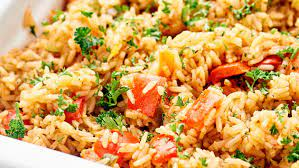Fun Facts about Rice
Do you know that there are over 120,000 varieties of rice grown worldwide? Mind-blowing, right? Rice is an increasingly important food in Nigeria. It is easy to produce and grows both for sale and home consumption. Traditionally seen as a luxury food reserved for special occasions only, with the increased availability of rice, it has become part of the everyday diet for many people in Nigeria. There are many varieties of rice grown in Nigeria; some of these are considered 'traditional' varieties, while others have been introduced within the last twenty years.
Fun Facts
- · Many cultures have evidence of early rice cultivation, including China, India, and the civilizations of Southeast Asia. However, the earliest archaeological evidence comes from central and eastern China and dates between 7000–5000 BC.
- · Uncooked rice can contain spores of Bacillus cereus, bacteria that can cause food poisoning. The spores can survive when the rice is cooked. If the rice is left standing at room temperature, the spores can grow into bacteria which will multiply and may produce toxins (poisons) that cause vomiting or diarrhoea.
- · Three main types of rice:
o
Long Grain Rice – It is three to four times as long as
it is wide, and light and fluffy when cooked.
o
Medium Grain Rice – shorter and wider
than long grain rice, and it is chewy, tender, and slightly sticky when cooked.
o
Short Grain Rice – Less than twice as
long as it is wide, and it is soft, tender and sticky when cooked.
- · Rice is one of the eight true cereals, along with wheat, oats, corn (maize), barley, rye, millet, and sorghum. There are 4 parts to the rice grain: the hull, bran, white rice, and germ.
- · Converted rice, also known as parboiled rice, is a type of rice that's been partially boiled and dried, which allows the rice to retain more nutrients compared to ordinary white rice.
- · Washing your rice prior to cooking it will eliminate any pesticides that may still be on the grain, help give it a consistent texture, and gets rid of excess starch. Generally, it is a good idea to rinse most types of rice, but always be sure to check the packaging on your rice first. Some rice comes enriched with water-soluble vitamins and minerals, which will dissolve if the rice is rinsed.




There is a difference between Rice four and Ground rice. Rice flour and ground rice are two different types of flour made from rice grains. The main difference between the two is the texture Rice flour is made by finely grinding cooked and processed rice grains into a fine powder. It is often used as a thickening agent in sauces and gravies, and it can also be used to make noodles, bread, and other baked goods. Ground rice, on the other hand, is made by grinding raw and unprocessed rice grains into a coarse powder. It is often used in baked goods, such as cakes and biscuits, as well as in puddings and porridges.
ReplyDeleteThere is a difference between Rice flour and Ground rice. Rice flour and ground rice are two different types of flour made from rice grains. The main difference between the two is the texture. Rice flour is made by finely grinding cooked and processed rice grains into a fine powder. It is often used as a thickening agent in sauces and gravies, and it can also be used to make noodles, bread, and other baked goods. Ground rice, on the other hand, is made by grinding raw and unprocessed rice grains into a coarse powder. It is often used in baked goods, such as cakes and biscuits, as well as in puddings and porridges.
ReplyDelete